Part 3 of 5 (Part 1 here; Part 2 here)
If Robert Lee had written his own memoir, he might well have started it with the same phrase Ulysses S. Grant used in his, “My family is American. . .”
In the America of the late nineteenth century of Grant and Lee—after enormous tracts had been released by the Louisiana Purchase and Lewis & Clark had gone on their expedition of exploration of the wild, wild west—there was a strong movement westward to fill in the spaces, and not enough people to populate them. So, began another wave of immigration into the U.S.
I suppose then it became a matter to pride to distinguish yourself from the new Americans, which was why Grant emphatically used that curious phrase.
Very few people could trace their lineage in America as far back as the two generals of the Civil War. Grant was descended from a Mathew Grant, who came to Massachusetts in 1630 from Dorchester, England (I wrote two blog posts on our visit to Thomas Hardy, the novelist’s house, in that Dorchester, Part 1 here, Part 2 here).
Lee’s ancestors were no slouches either. They came to America in 1646, but their English ancestors went back to the Norman conquest of England in the 11th Century, when a forefather, Launcelot de Lee, accompanied William the Conqueror from France.
Grant’s connection with George Washington was flimsy at best. Lee’s? Several. The first one:
Grant says nothing about the origins of the first Grant in America, perhaps because there was nothing to say, and that he had no aristocratic history.
Not so with Lee.
The Lees in England distinguished themselves variously over the next few centuries, and were even given an earldom, with the 2nd Earl of Lichfield building a grand mansion at their estate of Ditchley in Oxfordshire.
Lee’s direct progenitor was one Richard Lee, a younger son of an Earl of Litchfield, who had come to America in 1646 as a colonial secretary to the Governor of Virginia. Richard Lee probably needed to find a job, not being heir to either the title or the estates. (The law of primogeniture was (is?) strong in England—the oldest son inherited it all; the others made do as they could.)
When he was done with his tour of duty, Richard Lee settled in Westmoreland County. The Washingtons—of (eventual) George Washington fame—were neighbors, also newly come, along with the Fairfaxes.
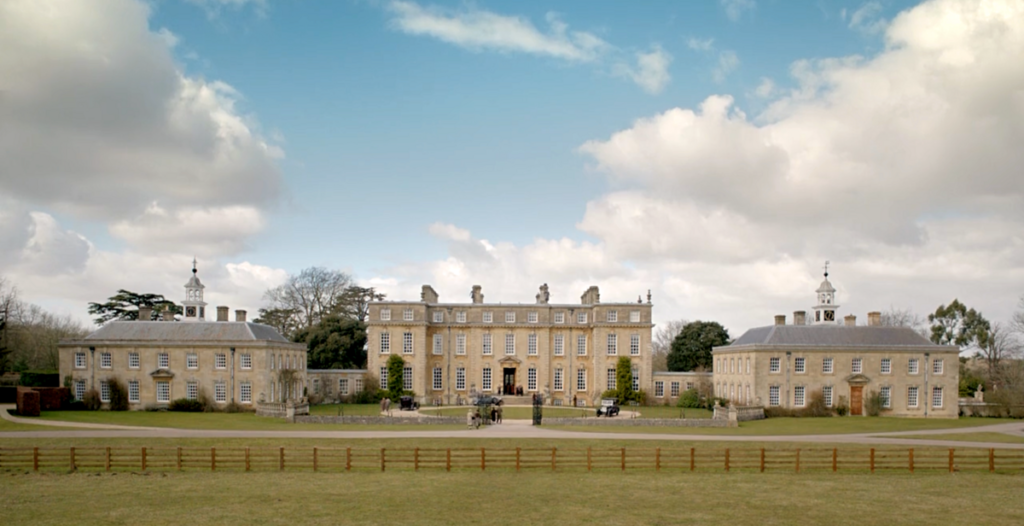
Ditchley House in Oxfordshire, the ancestral home of the English Lees, built by George Henry Lee, 2nd Earl of Lichfield. Image Source.
In Virginia, it was old hearty England again—the county families hunted over the hills and dales of Westmoreland, chasing the fox and the stag, built themselves grand mansions, and lived very much like the squires back home. The intimacy of these county families continued over generations, and Lee knew his wife, Mary Anna Randolph Custis, for a while before he proposed to her.
Although she was not directly related to Washington, Robert Lee would have a much closer association (sort of) to the first president of the United States through his wife, than his ancestors had with the early Washingtons—more on that when we get there.
The Lees go grand:
The third Lee in Virginia, one Thomas, who was descended from the Richard Lee who had pitched camp in America, took the Lee fortunes up high.
He built Stratford Hall on the Potomac River in the 1730s–it still stands, take a look at it below. Does is look somewhat like Ditchley House above? Maybe. . .the framing of the buildings is the same, the material different, of course, but there is the main wing, and the two supporting wings on either side.
Two of Thomas’s sons had a better claim in American history; they were Robert Lee’s granduncles, and did nothing less than sign the Declaration of Independence in 1776!

Stratford Hall Plantation on the Potomac River in Virginia, where Lee was born. Image Source.
Through a quirk of fate, Lee was born at Stratford Hall, although this Thomas Lee was not his direct ancestor, but his great-granduncle. It so happened that Robert Lee’s father was inhabiting the house at the time of his birth—by some sort of right, certainly.
Henry Lee had married his cousin, the daughter of the then-owner of the estate. When she died, she left one living son, who was, I think, to inherit the property. In the interim, Henry Lee occupied the mansion along with this second wife, Lee’s mother—thereby setting the stage for Lee’s birth.
A second George Washington connection:
Lee’s father, Henry, was a soldier, and fought during the Revolutionary War, eventually finding his way under George Washington’s command. So, he knew the future first president of the United States well, and was commended by him for bravery.
Henry Lee distinguished himself as a war hero and earned the dashing nickname of ‘Light-Horse Harry.’ To add to his accolades, he was subsequently a member of Congress, the governor of Virginia, became a private citizen, and married his second wife, Mrs. Anne Hill Carter (Lee’s mother), who was a wealthy widow.
This new combination of Henry Lees had three sons and two daughters. But by the time Robert Lee was born on January 19, 1807 (he was fifteen years older than Grant), his father had speedily damaged his name and his character. Henry Lee had been well on his way to becoming one of the most prominent citizens of this new America; he had the president’s ear, people thought well of him, foretold great things in his future. But he had gravely damaged his reputation.
The sins of my father:
Henry Lee had been speculating in land, selling and buying what did not belong to him, and getting into enormous debt. Home life became one big torment—he had to lock and bar his door against creditors and flee from men who came demanding their money in the street.
In 1808, when our Robert Lee was about a year old, unable to run anymore, Henry Lee gave himself up to the law and spent two years in a debtor’s prison.
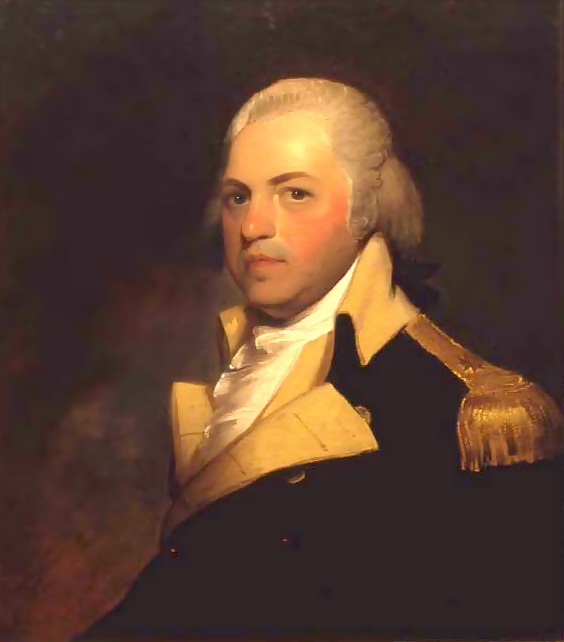
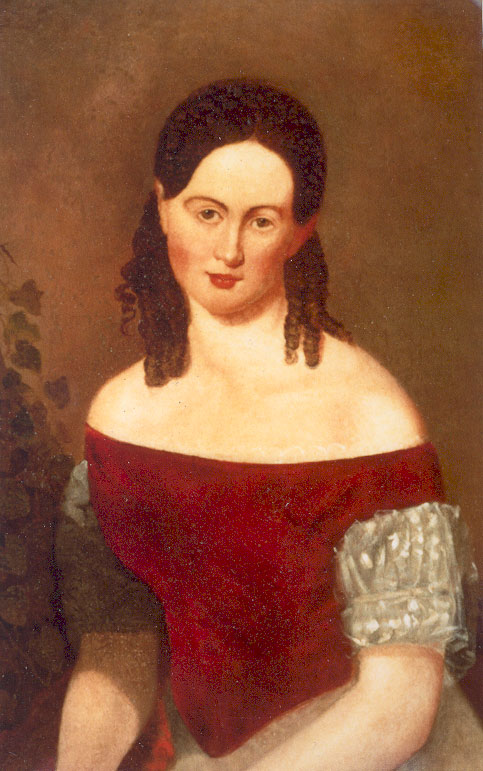
Lee’s father, Henry Lee (image source), and Lee’s mother, Anne Hill Carter Lee (image source).
Young as Robert Lee was when these misfortunes began, his father’s downfall would affect all his boyhood and young manhood. If the Union Army general, Ulysses Grant’s ancestors, were mere commoners–in England and in America–when compared to Lee’s ancestors who had polished their toes on the red carpet of American royalty by building mansions and signing Independence documents–their early years–which mattered in the making of both men–were vastly different.
Grant had a tranquil, bucolic, almost boring childhood. As for Robert Lee? His father was not done with his misdemeanors yet.
Henry Lee was a study in contrasts; brave one moment, brash and inconsiderate the next. After his stint in prison, he was injured while defending a friend’s house, and whether it was the injuries or the race to outpace his still-dunning creditors, he fled to the West Indies. He returned in 1817, and had got as far as Cumberland Island off Georgia’s coast when he died.
Henry Lee is buried on the island, and it was not until the Civil War that Robert Lee visited his father’s grave for the first time—a father he had barely known growing up, who had gone to prison the year after he was born, and was rarely at home after that.
The unnatural rigors of Lee’s boyhood:
Lee was born at Stratford Hall, the old family mansion in Westmoreland County in Virginia and spent the first few years of his life there. After his father was released from prison, the family moved to Alexandria, to rent from and be amongst the extended Lee clan.
Cameron Street was their first home.
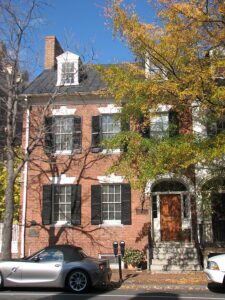
The Lees lived here first, in this red brick townhouse on Cameron Street. Image Source.
Given his father’s misadventures in life, and his absence most of the time, the one parent who was young Lee’s support, counselor, and guide, was naturally his mother. One by one, his brothers left for their careers, and by the time Henry Lee died (after his semi-exile to the West Indies), Robert Lee was the only male child at home.
He first went to school at the Alexandria Academy, and when he returned each day, attended to all the duties at home. His mother was by now somewhat of an invalid, and young Robert Lee harnessed their horses to the carriage daily, wrapped and placed his mother in, and took her for a drive. One of his sisters was in indifferent health also, and by all accounts it was Robert Lee who—under his mother’s guidance—ran the house, bought the groceries at the market and did all the outdoor chores.
This was women’s work at that time—even in a free and progressive America. Men went out into professions or ran their estates, women were reared to be wives and mothers. They had to learn how to run a house, give orders to the servants, decide the dinner menu if they had the means for it, or to cook it themselves it they had not. There were few professions open to women in the America of the early 19th Century.
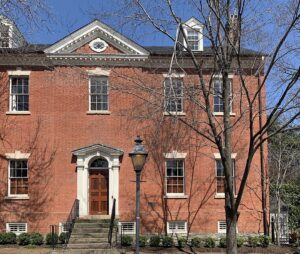
They had moved by now to their second home in Alexandria, on Oronoco Street.
The Oronoco Street townhouse from where Robert Lee attended school at the Alexandria Academy. Image Source.
Did Robert Lee meet a ghost from his future at the Alexandria Academy?
Look at the photo of the Alexandria Academy below–this narrow, upright building. There could not have been too many students crowded within its walls. And, it’s just possible. . .perhaps, just perhaps, that when Robert Lee was fourteen, he might have bumped shoulders with a newly-arrived student, Wilmer McLean, who was seven years old then.
From this time, for another three years, McLean and Robert Lee might have known/certainly seen each other, until Lee went to West Point.
Forty years later, Robert Lee would sign the surrender of the Confederate states and bring an end to the American Civil War in the front parlor of Wilmer McLean’s house at the village of Appomattox Court House.
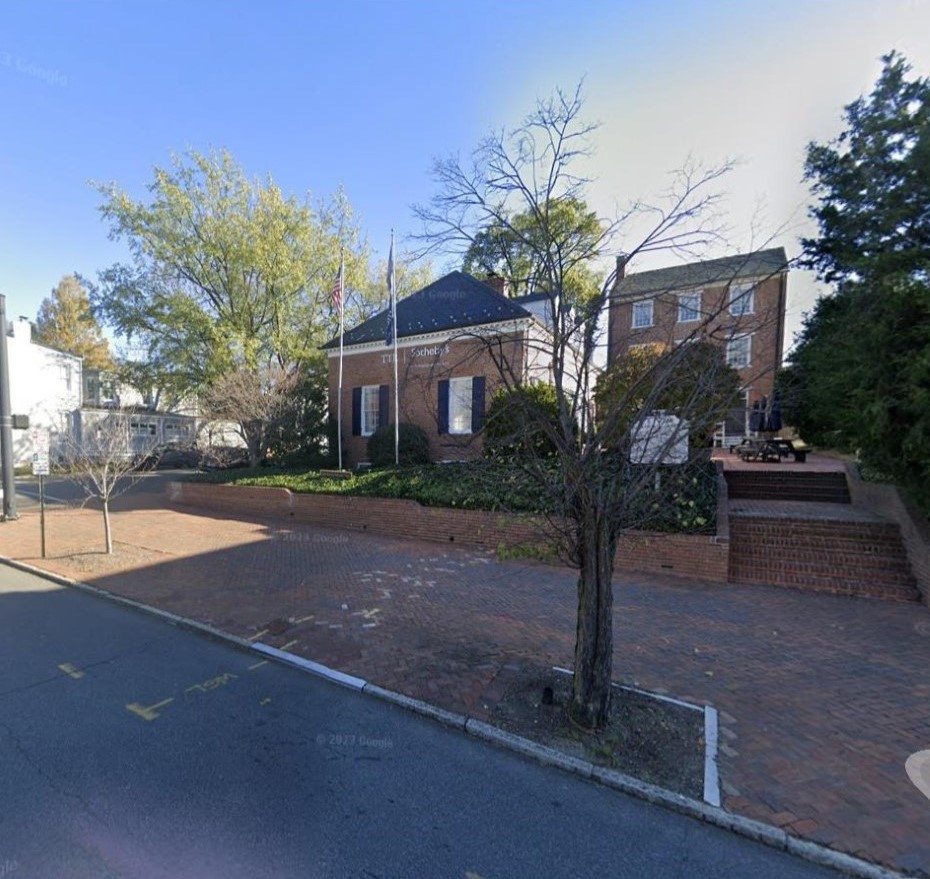
Perhaps I should also call this another George Washington connection, because the first president established (?) endowed anyhow the Alexandria Academy in 1785. In this slim building (on the right), which astonishingly still stands in Alexandria, Virginia, there were three schools on the three floors and the students were taught arithmetic, grammar, writing and science. Robert Lee probably walked here each day—half a mile one way from the Oronoco Street townhouse. Image Source: Google Street View.
So, this was Lee’s early life, perhaps from when he was ten years old—school, cossetting his chronically unwell mother, acquiring provisions for the house, giving instructions to the maids and the cook, chopping and hauling wood for the fireplaces, and keeping the carriage in good order.
He went to West Point at eighteen, until then, he was tethered to the house with burdensome little duties which no one seems to have shared with him.
And then, perhaps, he also remembered his father’s long years of irresponsible behavior which had kept them impoverished and dependent upon the mercy of relatives. As a consequence, he grew up somber, thoughtful, persistent in his studies and not inclined to (and not having time either) indulge in boyhood frivolities.
Unlike Grant’s more idyllic childhood, Lee did not skate on frozen ponds in winter, or fish for trout in summer streams. He worked all the time.
West Point Academy beckons:
There’s no real account of who sponsored Lee for West Point, or who nominated him. By 1824, someone. . .had decided this profession for him. So, he went from the Alexandria Academy to a school run by Mr. Hallowell to bring his mathematics up to speed for the entrance examination.
Here’s another (minor) point of connection between the two Civil War generals—Grant was also very proficient in math, in fact, had not wanted to be in the army at all, but had wanted to return to West Point as a math professor (see Part 2 of this blog post for Grant’s early life).
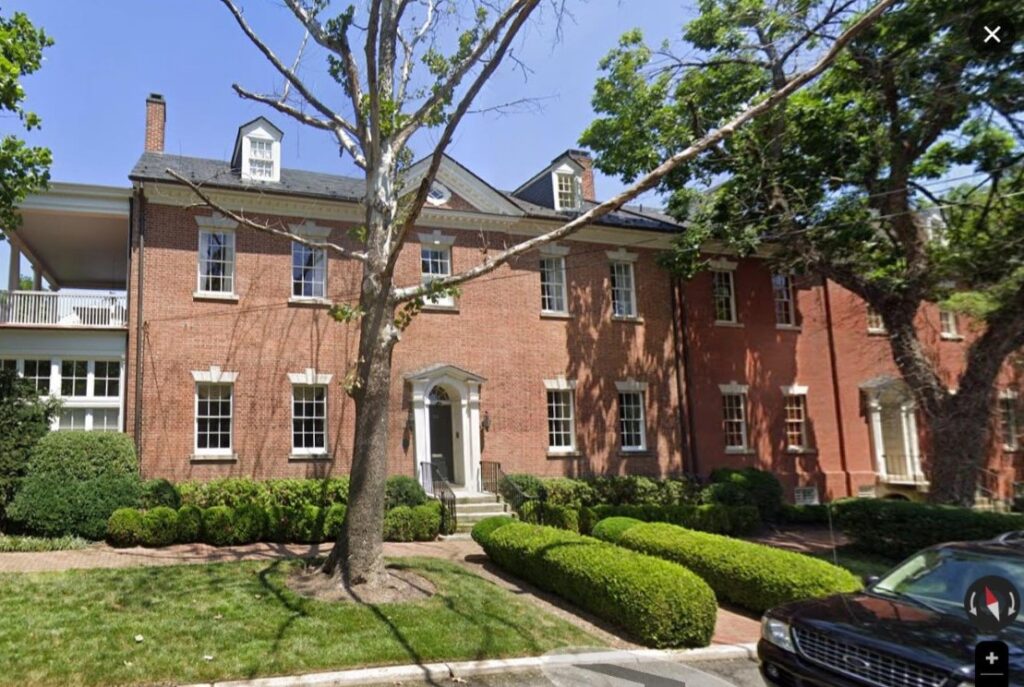
Benjamin Hallowell’s school was the other end of the townhouse on Oronoco Street that the Lees occupied (theirs is the darker blush brickhouse on the right). Image Source: Google Street View.
Hallowell was, at that time, a young man himself, and the red brick building he chose for his boarding school was right next door the Lee home, adjoined it, in fact. It was the first year of Hallowell’s school, and Lee was one of his first students.
Later, Hallowell was asked to recall the Confederate general, and he called him ‘an exemplary student,’ always on time, always conscientious, learned all his material, and drew his geometry diagrams with an exactitude and meticulousness even on a slate, which was to be rubbed off the next day. Lee’s manners were always courteous, whether to his teachers or his compatriots.
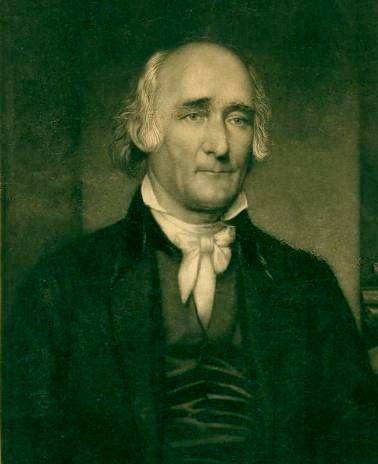
Benjamin Hallowell, whose Alexandria boarding school Lee attended in 1824. Image Source.
Given that Robert Lee left no autobiography, there are many speculations on his childhood, and Hallowell perhaps paints the best picture of a young Lee—studious, thorough, quiet, unobtrusive, respectful and. . .respected.
There are other accounts of Lee from family members who remember him as a child and a boy, but again, Hallowell’s is perhaps the most unprejudiced because he wrote this after the Civil War. By then, he knew what Lee stood for, and it was diametrically opposite to how he had lived his own life.
Hallowell was no measly pretender about the question of slavery, had no mere theoretical interest in the matter. Three years after Lee attended his school, in 1827, Hallowell and his Quaker friends formed a ‘Benevolent Society for Improving and Ameliorating the Condition of the people of Color.” The society actively helped free slaves through manumission and also wrote several anti-slavery articles.
Hallowell was a staunch abolitionist, and years later, when he was asked to be president of the Maryland Agricultural College (later the University of Maryland), he insisted he would do so only on the condition that no slaves were employed on the grounds.
Abolition was his life’s mission and he had so little in common with Lee, that his unbiased words about his erstwhile student are a valuable glimpse of a young Lee.
Lee was an exemplary student at West Point. . . .and exemplary beyond:
Robert Lee entered West Point in 1825, and he was, by all accounts a stellar student, meticulous in both his work and especially his appearance, his uniform neatly ironed, his brass breastplate shining at every review, and he never left the Academy after lights out to go drinking or carousing in the local tavern. He graduated second in a class of forty-six, acquired no demerits in all four years of his schooling and was appointed adjutant of his corps in his last year—the highest merit a cadet could get.
(Grant didn’t do quite as well—very mediocre in fact, graduating twenty-first in a class of thirty-nine, and, since he had a drinking problem in college, probably racked up demerits aplenty.)
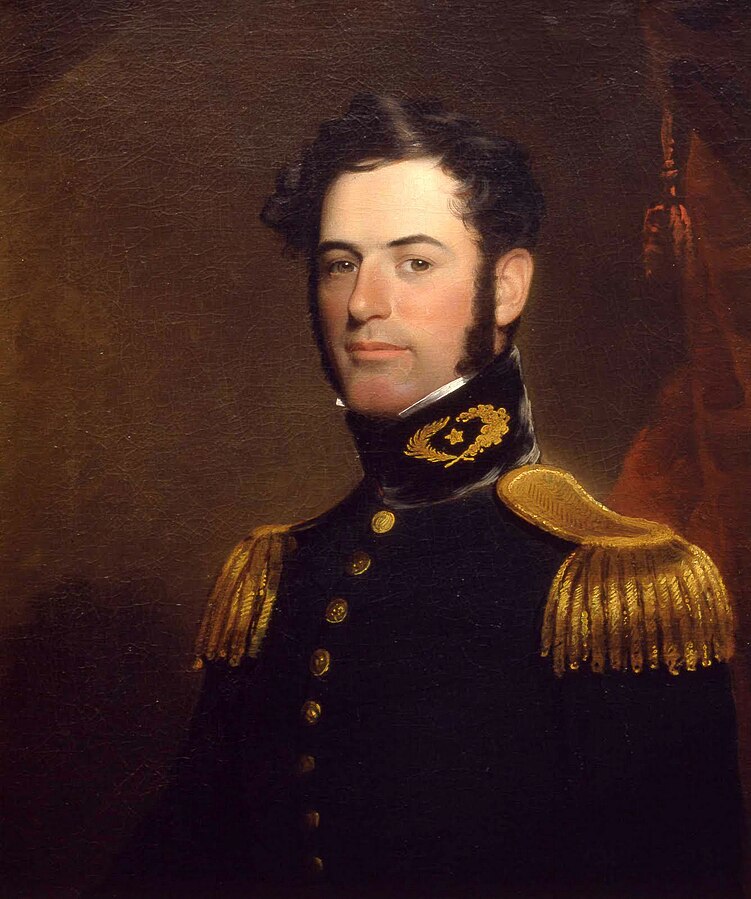
Lee at thirty-one, as a Lieutenant of Engineers in the U.S. Army. Image Source.
When he left West Point, Lee was sent to Fort Monroe as a brevet second lieutenant of the Engineer Corps. Two years into this posting, he married Mary Anna Randolph Custis.
The third George Washington connection:
The first president’s wife, Martha, had been married before and was a widow when she met George Washington. Her first husband, Daniel Parke Custis, had been an extremely wealthy plantation owner in Virginia, and they had four children together, of whom only one, John Parke Custis, survived to adulthood.
Martha was twenty-six when Custis died, and she inherited a large part of his estate for her lifetime; the rest was kept in trust for his children. She was then, one of the richest widows of the thirteen colonies when Washington married her, took charge of her portion, and became guardian to her then-two children. John Parke Custis was Washington’s stepson, certainly, perhaps also had been adopted by him.
John Parke Custis married early, and died early, leaving four children. His widow sent two, a girl named Eleanor, and a boy named for his step-grandfather, George Washington Parke Custis, to live at Mount Vernon with their grandmother and George Washington. As the only surviving son, Parke Custis inherited all of his father’s estate, and, after his grandmother’s death, the rest of his Custis grandfather’s estate which had been set aside for Martha during her lifetime.
George Washington Parke Custis married Mary Lee Fitzhugh, and their only surviving child, Mary Anna Randolph Custis—George Washington’s great-grand stepdaughter—became Lee’s wife.
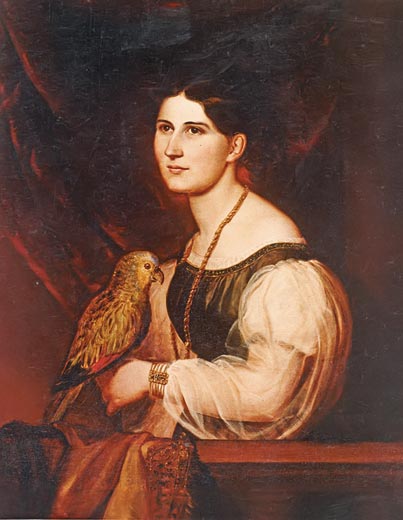
Mary Anna Randolph Custis Lee, owner of the estate at Arlington, and Lee’s wife. Image Source.
There was also a family link between the Fitzhughs (Mary Anna’s mother) and the Carters (Lee’s mother), and so he was distantly related to his wife.
Initially, père Custis was not very inclined toward the match—Lee’s father’s reputation as a Revolutionary War star had long been overlaid by his later life, the debts, the prison sentence, and the ignominy and the poverty that followed. But, he gave in, and Lee and Mary Custis were married at the Custis family plantation of Arlington on the 30th of June, 1831.
And so, Robert Lee strikes gold:
In the 1600s, the Lees of yore and the Washingtons of yore had been the first families in Westmoreland County in Virginia—they had known each other, danced and supped at each other’s estates, hunted together, fought in wars that had defined America as a nation freed from colonial rule, and had set the tone for very living. Lee himself, had come down considerably in the world—at least, his family had, and the glory was in the past.
But now, when Lee married George Washington’s great-grand stepdaughter, he stepped into American royalty. It was a splendid alliance for him. His wife was to inherit all of the original Custis property, including Arlington; he was now connected with the first president’s family, and he would be blindingly rich.
The new Mrs. Lee was also heir to the old Custis plantation of White House on the Pamunkey River where George Washington had married Martha, because she had owned it then.
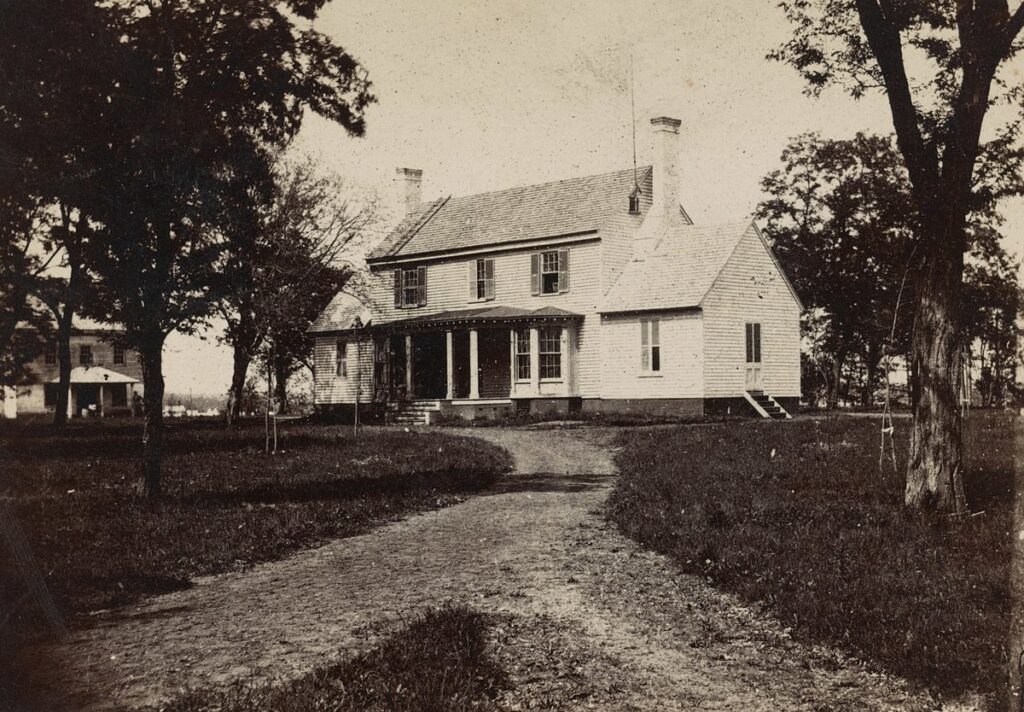
The White House Plantation where George married Martha. Perhaps, just perhaps, the presidential residence in the U.S. is called after this plantation. George Washington, the first president, never lived in the presidential manor, the White House, but perhaps, he gave it its name after a place where he had lived in happiness. Image Source.
George Washington owned slaves at Mount Vernon. Martha Washington owned slaves in her Custis inheritance, and all the subsequent Custis sons owned slaves. The Arlington estate was run on slave labor; in time, Robert Lee would inherit the estate and the slaves.
It’s a splendid life?
The Lees set up house at Arlington and eventually had seven children. Lee gained his promotions steadily, still in the Engineering Corps, and was posted to Washington—a short ride from his home. (This proximity of the Arlington Plantation to Washington, D.C., would eventually affect the fortunes of future Lees—more, toward the end of this post).
In 1837, he was sent by the Engineering Department to the Mississippi River at St. Louis, to survey the harbor with its troublesome sandbanks that did not allow for deep water moorage near the shore. He also had to tame the rocks and rapids on the Des Moines River and the Rock River.
Other engineering postings followed; Robert Lee was raised to the rank of a captain of the U.S. Army in 1838; he was sent to Fort Hamilton in New York harbor to bolster its defenses, and was appointed on a board at West Point.
The Mexican-American war of 1846-48:
At this point, Grant—the reluctant soldier—was still trying hard to get himself an assistant professorship at West Point. He wanted to leave the army and teach math. But the Mexican War drew him in, and he went in with the rank of a lieutenant.
Lee, in the first year of the war, was probably on an overland route into Mexico—under General J. E. Wool’s command, via San Antonio, over the Rio Grande, maybe as far as Saltillo. His actions in that theatre of war brought him to the notice of the commander-in-chief of the U.S. Army in this Mexican conflict, General Winfield Scott.
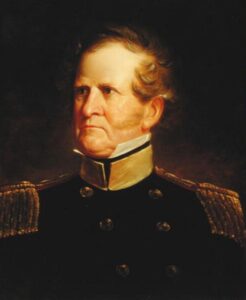
General Winfield Scott, some ten years before the Mexican War. Image Source.
Scott was then embarking into the Gulf of Mexico to attempt landing at Vera Cruz, to capture the city, and then make his way up to the capital. Along with his cavalry and infantry regiments, he also took along a strong contingent of artillery and engineers.
However the invitation came, Lee was under Scott’s command by March of 1847, and had designed the battery that was to assault Vera Cruz. One of the officers manning a gun was his older brother, Sydney Smith Lee, a lieutenant in the U. S. Navy.
Vera Cruz fell, and the U. S. Army began the long march over some perilous terrain of hills and valleys toward Mexico City. A narrow pass defended by the enemy almost defeated them, until Lee and a fellow engineer, Captain Beauregard, set about blasting rocks and finding an alternate route.
The Lee-Beauregard connection began here? And led to the Civil War?
Remember Beauregard from Part 1 of this blog post? Perhaps his friendship with Robert Lee was cemented in this action of the Mexican War, and some fifteen years later, he would serve as a general under Lee’s command, both beginning the Civil War in the First Battle of Bull Run (at Manassas) and while not exactly ending up at Appomattox (at the end of the war), surrendering with General Johnston some twenty-seven days later to General Sherman of the Union Army at Durham, North Carolina.
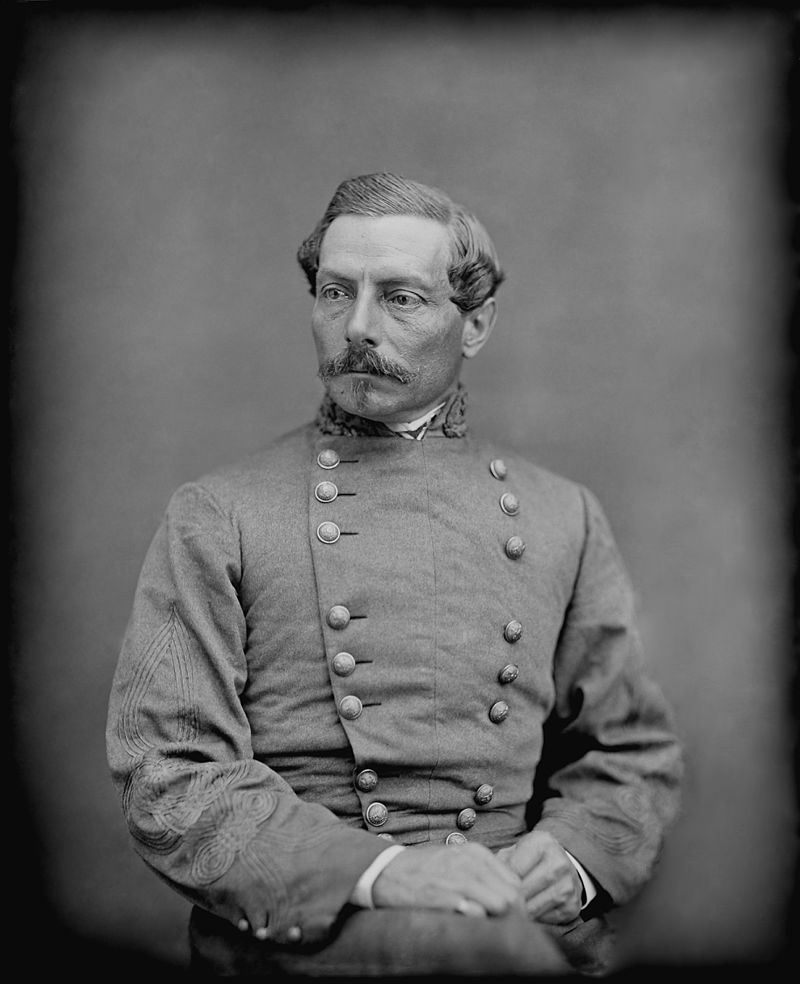
General Pierre Gustave Toutant Beauregard. Image Source.
Beauregard, for the Manassas/Bull Run battle, set up his headquarters in a large mansion nearby called Yorkshire, belonging to a Wilmer Mclean. One of the first Union shells fired during that first battle was directed toward this house, and it went through the walls of the log cabin on the grounds that was the kitchen—while dinner was being cooked.
(After the Second Battle of Bull Run, a year later, Wilmer Mclean moved two hundred miles away. . .to Appomattox Court House. And, Lee and Grant followed him into his then-home in that village for the surrender. Wilmer McLean then, personifies the ‘Manassas to Appomattox’ phrase that defines the beginning and end of the Civil War better than anyone else in the history—much more on McLean when we get to Part 5 of this blog post.)
Back at the Mexican War. . .Lee gets promoted:
General Scott raised Lee to a brevet rank of major after Vera Cruz, and eventually put him on his staff.
By the end of the war, Lee had served with several officers he would encounter at one end or the other of the Civil War. Just as Grant found his generals among early-and-late acquaintances, and knew others who were to be his Confederate antagonists, Lee served during the Mexican War with Joseph E. Johnston (who made the final surrender of 90,000 troops to end the American Civil War), Longstreet, and Albert Sidney Johnston.
(Grant knew Longstreet much more intimately; the latter had graduated from West Point a year after Grant, and was at his wedding. Historians are still speculating about just how close their friendship was—and whether Longstreet had been Grant’s best man.)
Sometime during the Mexican War, Grant and Lee met each other—their only encounter, despite their both being West Point graduates, part of the U.S. Army, and having served with many officers they both knew well.
Perhaps before, it was their age difference that had kept them apart—Lee graduated from West Point ten years before Grant. And during this Mexican War, they were, essentially, asunder in their ranks—Lee was on General Scott’s staff, Grant a mere lieutenant.
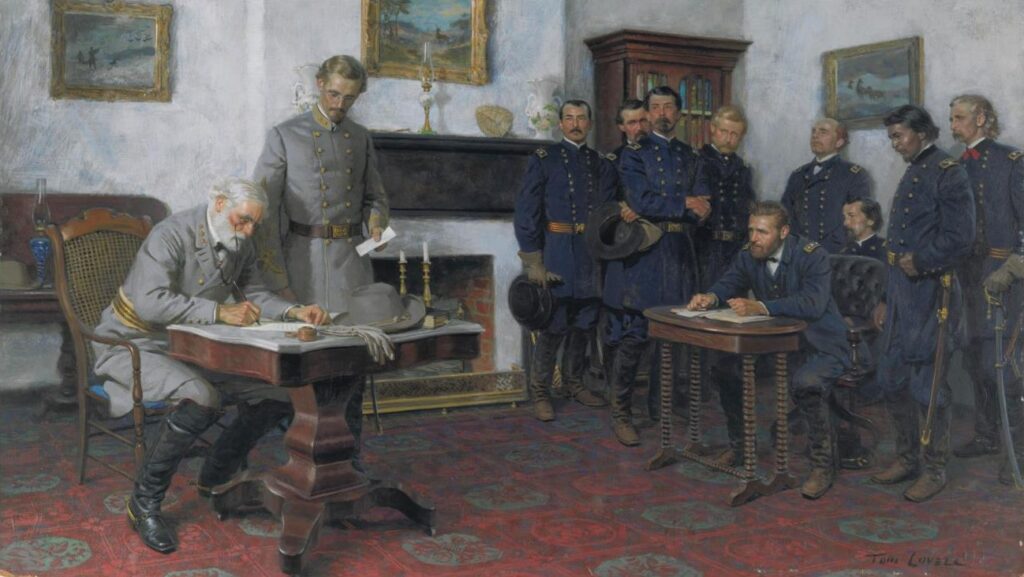
Lee signing the surrender documents on April 9th, 1865, in Wilmer Mclean’s front parlor in Appomattox Court House. Before they got to this point, Grant—trying to ease the awkwardness of their situations—made some small talk, and mentioned their meeting during the Mexican War. Perhaps it helped; in any case, it was a meeting—necessary, but at the end of an exhausting, expensive war—that could by no means have been remotely easy for either Grant or Lee. Painting by Tom Lovell from here.
The meeting was perhaps nothing more than Lee riding over to Grant’s army contingent and giving a somewhat large assembly of officers orders from General Scott. Maybe something about next steps, planning, movements of troops. . . Whatever it was, when Grant and Lee met at Appomattox Court House so that Lee could surrender, Grant mentioned this happenstance in the Mexican War, some twenty years ago.
Lee did not remember him—there was no way he would, but he was courteous enough to say that Grant must have been there, but sorry, can’t recall your face.
At West Point again:
Lee was rewarded for his services during the Mexican War with an appointment as superintendent of West Point Academy in 1852. By this time, his oldest son, George Washington Custis Lee was at the institution.
Custis Lee graduated at the top of his class, and like his father, was cadet adjutant of his corps in his final year, and again, like his father, chose to go into the Engineers.
He would go on to fight in the Confederate Army in the Civil War, and would eventually be captured—two days shy of the surrender—at the Battle of Sailor’s Creek, which was on the path Robert Lee was taking toward the village of Appomattox Court House.
Lee, officially, becomes a slave owner:
At the end of three years, Lee was raised to a Lieutenant-Colonel and assigned to lead a new cavalry corps, posted to western Texas. While he was here on duty, in this heated, dusty, dreary land as Texas was then, he was recalled to Arlington when his wife’s father died in 1857.
The plantation and the slaves—through his wife—now belonged to Lee. His father-in-law had also, in his will, dictated that the around 200 slaves at Arlington were to be given their freedom as soon as possible, but not later than five years after his death.
Lee caught onto that clause—that five years. The estate was in trouble, in debt, and not producing as much crop as it was capable of, he could not afford to let the slaves go.
There was no overseer on the land. Lee tried to hire one, but failed and so he took over the management of Arlington himself, along with being executor to the two other Custis properties, which were left to two of his sons.
Arlington. . .does it sound familiar? It should do:
George Washington Parke Custis—Lee’s father-in-law—inherited this northern Virginia land from his own father, who had been George Washington’s stepson. Having been in such close proximity to the first president of the United States, and having been his only son, so to speak, the elder Custis had amassed a great deal of George Washington’s property, moveable that is, swords, papers, paintings maybe.
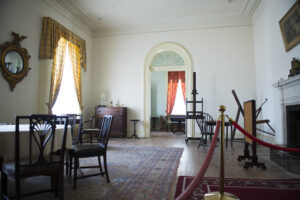
The main drawing room, I think, at Arlington House. Image Source.
Lee’s father-in-law moved from the family estate of Arlington on the Chesapeake Bay, two hundred and twenty-five miles south of Washington, D.C, and began building Arlington House here in northern Virginia, with the idea that it would house Washington memorabilia, and be a monument to the first president.
As a house, it was the first of its kind in America—in Greek revival architecture, with giant Doric pillars in the front porch, mellow marble-like plaster, and a triangular pediment over the front. Lee and his wife were married in this mansion.
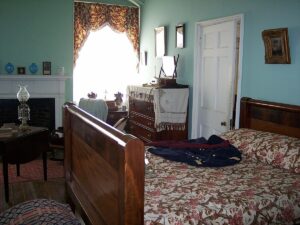
The main bedroom in Arlington House today—Lee and his wife occupied it, after his return to the plantation as its owner. Not for long though; they left it even before the Civil War officially began. Image Source.
It’s a nice bit of land that, Arlington, west of the Potomac River, and just across the water from the White House. That White House, where President Abe Lincoln lived when the Civil War was to begin.
That close. And too close for comfort when Virginia seceded from the Union in 1861. Robert Lee left the U.S. Army in April, by May, his wife had moved out of Arlington. A couple of weeks later, it was in the hands of the Union Army.
Then, followed some wrangling—and we’re getting into Civil War and post-war years here. The U.S. government confiscated the property, they cut trees down, they buried some dead. Lee’s son—inheritor of the estate—filed a case against the government some ten years after the end of the war, he won, and was paid compensation.
The Arlington National Cemetery had come officially into being. And, on the grounds, still, is the mansion that Robert Lee lived in, that his father-in-law built.
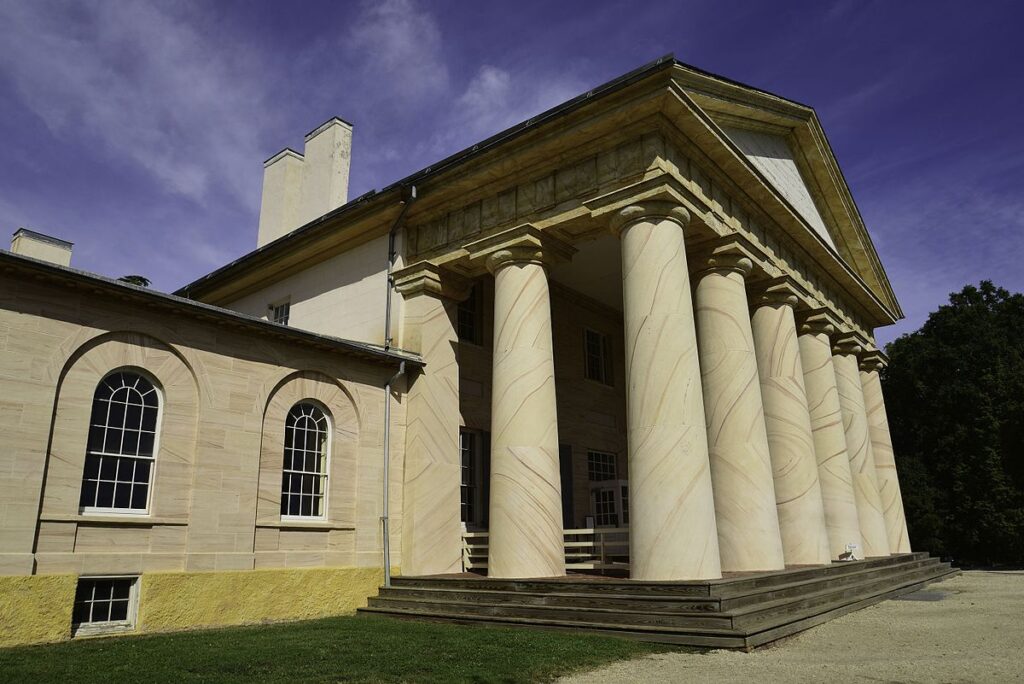
Arlington House, the plantation, as it is today within the grounds of the cemetery. Image Source.
Lee and the slaves at Arlington:
Lee was a hard taskmaster, rigid in discipline, ruthless in punishment to the slaves. They rebelled, having expected to be freed when Custis died, and justly not wanting to wait until the five years were over when Lee would be obliged, by law, to manumit them. Three men, Reuben, Parks and Edward went into revolt and Lee had them sent to jail.
Three others of the Norris family, two men and a woman, escaped from Arlington and fled northward, but they were captured and brought back.
Lee had his slave overseer, Gwin, tie them to posts in a barn and strip them to the waist. Gwin balked at carrying out the next part of the penalty —fifty lashes of the whip for the men, twenty for the woman. So Lee called for the county constable, who wielded the whip instead—egged on by Lee to ‘lay it on well,’ which order he followed assiduously.
Lee did not raise the whip himself, but when the deed was done, he ordered the constable to pour brine over their lacerated wounds as further punishment.
On December 29th, 1862, Lee manumitted all the slaves on the Arlington estate—according to the will of his father-in-law, he could not legally hold them any longer.
Grant had a John Brown connection. . . Lee also:
Grant’s father had learned his abolitionist views from John Brown’s father, by whom he had been employed in Owen Brown’s tannery. (See Part 2 of this blog post). Grant’s father had known John Brown both as a boy and a man, and had thought him to be honest, upright, gentlemanly, but with a ceaseless fire and fervency which was little short of madness.
In October, 1859, John Brown, with a pitifully small ‘army’ of twenty men raided the armory at Harper’s Ferry and took people hostage. He had wanted to rouse the slaves into rebellion, and was hoping to show them the way.
Lee was at Arlington at that time, still looking after matters on his wife’s estate, and was asked to lead a contingent to capture John Brown. He did, and Brown was subsequently executed.
The first rumblings of the Civil War had begun.
The Confederate General leaves the U.S. Army, setting the stage for his part in the American Civil War:
A year later, in November, 1860, Abraham Lincoln was elected president. The Civil War was now imminent. Even before his inauguration in March of the next year, seven southern states had seceded—not Lee’s home state of Virginia. . .yet.
General Winfield Scott, commander-in-chief of the Union forces, doubtless remembering his time with Lee during the Mexican War, offered Lee a top command in the army.
Lee dithered; it was obvious Virginia would not stay in the Union either, and it didn’t. Three days after Virginia’s secession, on the 20th of April, 1861, Scott accepted Lee’s resignation—and now, it was clear that Lee was going to be on the Confederate side.
Initially, the Governor of Virginia gave Lee the rank of major-general and command of all of Virginia’s forces. Lee subsequently took over the Army of Northern Virginia.
Two months before the end of the Civil War, he was appointed General-in-Chief of the Armies of the Confederate States—he led all the Confederate armies.
Two months after that, he was at Appomattox Court House, surrendering to Grant.
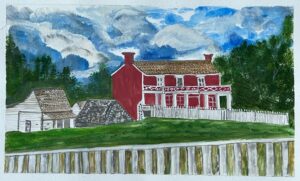
If you’ve enjoyed reading this blog post, please consider sharing it, so others may read also. Thank you!
Keyword Phrases: Surrender at Appomattox Courthouse; Battle of Appomattox date; Appomattox Court House date; Appomattox Battle Significance; who surrendered at Appomattox Court House; Who won Appomattox; Where is Appomattox.
On the next blog post—an announcement–my lecture for the Singapore museums on May 27th, 2024–Power Behind the Veil–Life in the harems of India’s Mughal Empire
Primary Sources: Campaigning with Grant by General Horace Porter, 1897; Lee at Appomattox by Charles Frances Adams, 1902; Various NPS brochures; The End of an Era by John S. Wise, 1901; Personal Memoirs of U. S. Grant, 1894; The Life of General Robert E. Lee by G. Mercer Adam, 1905; A Personal History of Ulysses S. Grant by Albert D. Richardson, 1885; Ulysses S. Grant by Owen Lister, 1901; Memoirs of Robert E. Lee by A. L. Long, 1885; Life and Letters of Robert Edward Lee by Rev. J. William Jones, 1906; Biography of Wilmer McLean by Frank P. Cauble, 1969.



2 Replies to “The end of the American Civil War–Appomattox Court House–All About Robert Lee–Part 3”